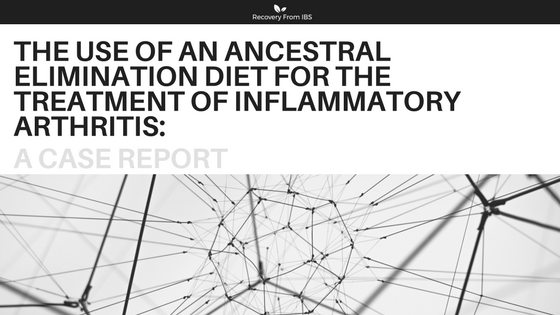
Introduction:
This is a case study of a patient who experienced improvement of inflammatory arthritis from a treatment plan that consisted almost exclusively of an ancestral or “paleo” elimination diet. After the initial 30 day elimination period, the patient reported a 51% reduction in total symptoms, and significantly less pain and flexibly in the affected joints. She also reported a welcome 6.5 pound weight loss, improved mood, and improved gastrointestinal symptoms. She was then able to successfully reintroduce a number of foods while furthering her symptomatic improvement.
Case Presentation:
This 45 year old female Caucasian marketing manager (Jane*) requested a nutrition care plan to improve her inflammatory arthritis, as well as to improve her overall health. Approximately 2.5 years prior, she had begun experiencing joint pain in her right knee. At that time, she was under a great deal of stress and was working long hours. At the time of
initial consult, she was experiencing significant pain and swelling in her right knee and both feet. MRIs showed inflammation and swelling without structural damage in the knee, and bursitis without synovitis in both feet. She experienced temporary improvement in her knee with a steroid injection and in her feet with acupuncture. Jane’s rheumatologist suggested the medication Methotrexate as a means of reducing inflammation, but Jane wished to first explore alternative/dietary approaches to reducing inflammation.
Jane had no other medical diagnosis. She reported blood pressure of 130/70 and resting heart rate of 61. She provided the following labs:
- Rheumatoid factor – negative
- ESR (erythrocyte sedimentation rate) – normal
- C-Reactive Protein – normal
- Anti-cyclic citrullinated peptide (anti-CCP) antibodies – negative
- Anti double stranded DNA – normal
- Anti-nuclear antibodies – positive but ‘not v high’
Jane had a family history of cancer, hypertension, and glaucoma. She reported a height of 64″ and a weight of 137 pounds, with a BMI of 23.52. She reported a 20+ year history of yo-yo dieting, with weight fluctuating between 130 and 170 pounds. Her exercise consisted of walking approximately 90 minutes 7 days per week.
For the previous two years leading up to the consult, Jane had followed a 5:2 intermittent fasting pattern for weight control. This fasting pattern features 5 days of normal eating and 2 days of very low calorie (~500kcal/day) intake per week. Jane ate 3 meals and 2 snacks each day, with less than 25% eaten out. Comfort foods and cravings included tea, cake, biscuits, chocolate, baked goods (toast/scones/crumpets), red wine, and crisps. One food diary day of eating for Jane was oats with yogurt and fruit for breakfast, sandwich or soup and salad for lunch, meatballs with rice and broccoli for dinner, and chocolate with digestive biscuits, squash, and wine in the evening. She drank 3-6 cups of black tea with milk per day.
Jane was taking the following dietary supplements: EPA/DHA omega-3 fish oil 1800mg – 2 caps/day , vitamin D3 10ug – 2 caps/day, Feroglobin Gentle Iron supplement (17mg iron fumarate) with B6, folic acid, B-12, zinc, and copper – 1 cap/day. She was not on any medications.
Her initial total symptom score was 47, with reported symptoms of joint pain, arthritis, stiffness/limited movement, belching, bloating, flatulence, spoon shaped/brittle nails, dry skin, coating on tongue, mood swings, anxiety, anger, poor memory, and poor concentration.
Management and Outcome:
Jane was given the following nutrition care plan:
- 30 day ancestral/paleo elimination diet (followed by re-introductions):
- 100% eliminate: gluten, dairy, soy, legumes, eggs, and tree nuts
- Limit: refined sugar, refined flour, gluten-free grains, white potatoes, sweeteners/additives/food dyes
- Do not limit healthy fats. Use olive and avocado oil, coconut oil, goose or duck fat, or diary-free ghee.
- Track intake with a goal of 25grams+ of daily fiber (mostly from vegetables, fruit, nuts, and seeds)
- Grass-fed meat, free-range pork, and organic poultry are recommended as ideal.
- Work to incorporate daily intake of bone broth, collagen gummies, and/or collagen hydrolysate protein
- 5:2 fasting routine: no changes needed
- The resources provided were a meal plan, a detailed food/ingredient list, a gluten-free guide, and links for needed items/ingredients.
- Exercise and stress management/reduction recommendations and resources were also provided.
At 34-day follow-up, Jane had a total symptom score of 23, a 51% reduction.
She reported that her feet “definitely feel better; they are more flexible and less painful when I get up in the morning”. She also noted that “I’ve been able to return to some strength training, doing bodyweight squats”. She also was happy with a 6.5 pound weight loss. She additionally reported improvement of gastrointestinal symptoms and mood/emotions.
At this follow-up, Jane was provided with food re-introduction instructions, beginning with eggs, dairy, and tree nuts (usually included on an ancestral diet). The next food re-introductions were legumes, white potatoes, gluten-free whole grains, and gluten.
At 48- day follow-up, Jane reported further symptomatic improvement: “my feet feel almost normal when I get up in the morning, very few aches and pains, and I’ve noticed a reduction in the swelling in my toes”. She also reported a total of 10 pounds weight loss (BMI now 21.8). She had successfully reintroduced eggs and dairy at that point.
Discussion:
Ancestral or ‘paleo’ diets have been shown by clinical trials to reduce inflammation and to improve weight, insulin sensitivity, and dyslipidemia (1-8). They can be used professionally with an elimination diet approach, to achieve outcome goals while also broadening the diet as much as possible. A well-designed ancestral diet is nutrient-dense, with a high amount of vegetables and fruit, a moderate amount of well-sourced animal protein, nutrient-rich fats, nuts and seeds, and additional foods as tolerated by the patient. Food/nutrient trackers can be used to ensure that the patient is meeting dietary requirements during the elimination and, in fact, their nutrient status usually improves on the elimination diet.
This case study provides an example of the professional use of an ancestral elimination diet to improve inflammatory arthritis. The patient was provided with an initial 30-day full elimination period, followed by systematic re-introductions. Resources such as meal plans, recipes, and handouts were used to make the elimination diet easier and more successful.
Foods were reintroduced individually, each over several days at increasing amounts. The patient was able to reintroduce a variety of foods while continuing symptomatic improvement.
As many chronic medical conditions have a component of inflammation, insulin resistance, obesity, and dyslipidaemia, a dietary approach that addresses these issues is an incredibly valuable clinical tool. Ancestral elimination diets have been shown to yield these improvements (1-8). They can be used effectively by nutrition professionals to achieve significant clinical outcomes. When doing so, it is important to provide the patient with helpful resources for both the elimination and reintroduction phase. It is also essential that the patient receive ongoing support and follow-up.
*NOTE: name has been changed for patient anonymity.
Finally, I’d love to hear from you! Have you used an ancestral or paleo diet either personally or professionally? If so, what were the results and/or challenges? Please post either in the comments or send me an email!
Warm regards,

Erin Skinner, MS, RD, IFNCP, CPT
References:
- Frassetto, L.A., Schloetter, M., Mietus-Synder, M., Morris, R.C. and Sebastian, A. (2009) ‘Metabolic and physiologic improvements from consuming a paleolithic, hunter-gatherer type diet’, European Journal of Clinical Nutrition, 63(8), pp. 947–955. doi: 10.1038/ejcn.2009.4.
- Jönsson, T., Granfeldt, Y., Ahrén, B., Branell, U.-C., Pålsson, G., Hansson, A., Söderström, M. and Lindeberg, S. (2009) ‘Beneficial effects of a Paleolithic diet on cardiovascular risk factors in type 2 diabetes: A randomized cross-over pilot study’, Cardiovascular Diabetology, 8(1), p. 35. doi: 10.1186/1475-2840- 8-35.
- Kowalski, L. and Bunko, J. (2012) ‘Evaluation of biological and clinical potential of paleolithic diet’, Rocz Panstw Zakl Hig, 63(1), pp. 9–15.
- Lindeberg, S., Jönsson, T., Granfeldt, Y., Borgstrand, E., Soffman, J., Sjöström, K. and Ahrén, B. (2007) ‘A Palaeolithic diet improves glucose tolerance more than a Mediterranean-like diet in individuals with ischaemic heart disease’, Diabetologia, 50(9), pp. 1795–1807. doi: 10.1007/s00125-007- 0716-y.
- Manheimer, E.W., van Zuuren, E.J., Fedorowicz, Z. and Pijl, H. (2015) ‘Paleolithic nutrition for metabolic syndrome: Systematic review and meta-analysis’, American Journal of Clinical Nutrition, 102(4), pp. 922–932. doi: 10.3945/ajcn.115.113613.
- Masharani, U, et al. “Metabolic and Physiologic Effects from Consuming a Hunter- Gatherer (Paleolithic)-Type Diet in Type 2 Diabetes.”European Journal of Clinical Nutrition, vol. 69, no. 8, 1 Apr. 2015, pp. 944–948.
- Ryberg, M., Sandberg, S., Mellberg, C., Stegle, O., Lindahl, B., Larsson, C., Hauksson, J. and Olsson, T. (2013) ‘A Palaeolithic-type diet causes strong tissue- specific effects on ectopic fat deposition in obese postmenopausal women’, Journal of Internal Medicine, 274(1), pp. 67–76. doi: 10.1111/joim.12048.
- Österdahl, M., Kocturk, T., Koochek, A. and Wändell, P.E. (2007) ‘Effects of a short- term intervention with a paleolithic diet in healthy volunteers’, European Journal of Clinical Nutrition, 62(5), pp. 682–685. doi: 10.1038/sj.ejcn.1602790.
